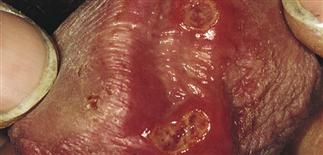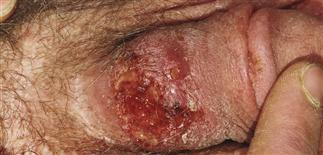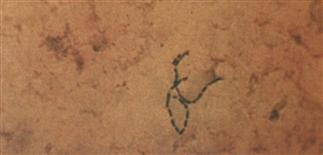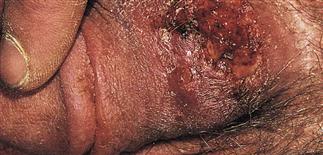54
Chancroid

Several small, painful ulcers are usually present. The base is purulent, in contrast to the chancre of syphilis, which is not painful.

The ulcers have coalesced during a 4-week period without treatment.

Wright’s stain of purulent material of the base of the ulcer shows a chain of coccobacilli characteristic of Hemophilus ducreyi.

Deep ulcers bleed easily and spread laterally. They are highly infectious. Lymphadenopathy occurs in 50% of cases.
DESCRIPTION
Chancroid is an uncommon sexually transmitted disease caused by Hemophilus ducreyi. It is characterized by painful genital ulceration and inguinal lymphadenopathy.
HISTORY
• More common in heterosexual men who obtain it from prostitutes who are usually asymptomatic carriers. • Common in certain developing countries but uncommon in the USA. • Coinfection with HIV is common.
DISCUSSION
• H. ducreyi cannot be cultured on routine media. Newly formulated transport media can maintain the viability of the organism. A cotton swab is used to obtain a specimen at the base of the ulcer, which is then rolled over a glass slide. Gram-negative clumped organisms, resembling a school of fish, can be seen and are diagnostic. • High rate of coinfection with HIV among patients with chancroid, so HIV test is reasonable in these patients. Also consider syphilis serologies. • Herpes simplex is the most common form of genital ulceration in North America. However, the combination of painful genital ulceration and ulcerative or suppurative inguinal adenopathy is highly suggestive of a diagnosis of chancroid in the right clinical setting. • Treatment of chancroid should not be delayed for culture results if the disease is suspected. Prolonged genital ulceration from the disease may increase the risk and susceptibility for HIV transmission.
PHYSICAL FINDINGS
• A painful, red papule first appears at site of inoculation, followed by a pustule, which may rupture, forming an ulcer surrounded by a bright-red base. • The ulcer of chancroid is deep, bleeds easily, and may spread laterally. It is covered by a yellow-gray fibrinous exudate. These ulcers are highly infectious and may become multiple via autoinoculation. This can occur on thighs, buttocks, and anal area. • Patients may feel ill, with fever, anorexia, malaise. Unilateral or bilateral inguinal lymphadenopathy develops in 50% about 1 week after infection. Lymph nodes may suppurate and ulcerate or resolve spontaneously. • Women may carry the organism but display no clinically detectable lesions and have no symptoms. Untreated cases either resolve spontaneously or become chronic and require a long time to heal.
TREATMENT
• Azithromycin: 1 g orally in a single dose can be curative. • Ceftriaxone: 250 mg i.m. in single dose is also all that is needed. • Ciprofloxacin: 500 g b.i.d. orally for 3 days. Erythromycin: 500 mg t.i.d. orally for 7 days.







